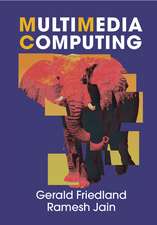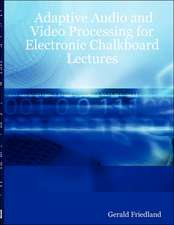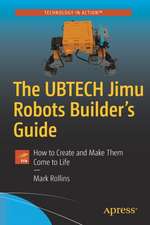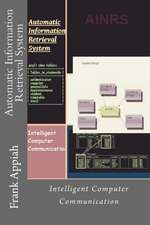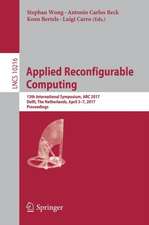Beginning Programming Using Retro Computing: Learn BASIC with a Commodore Emulator
Autor Gerald Friedlanden Limba Engleză Paperback – 11 dec 2018
You can also use this book as an opportunity to dust off your computing skills or learn programming concepts for the first time on a system that’s easy, approachable, and fun with a nostalgic twist.
Commodore computers were the most sold computing devices before the iPhone. Nowadays, the Commodore system can be run using freely available emulation on modern computers. This book uses VICE,which is available for PC, Mac, Linux, as an online app, and on the Raspberry Pi. Beginning Programming Using Retro Computing offers simple programming concepts to give children and adults alike a sense of wonder in seeing that words they write have the power to do things, like play sounds, draw graphics, or finish math homework.
Preț: 129.15 lei
Preț vechi: 161.44 lei
-20% Nou
Puncte Express: 194
Preț estimativ în valută:
24.72€ • 26.84$ • 20.76£
24.72€ • 26.84$ • 20.76£
Carte disponibilă
Livrare economică 01-15 aprilie
Preluare comenzi: 021 569.72.76
Specificații
ISBN-13: 9781484241455
ISBN-10: 1484241452
Pagini: 100
Ilustrații: XV, 90 p. 85 illus., 76 illus. in color.
Dimensiuni: 178 x 254 x 10 mm
Greutate: 0.2 kg
Ediția:1st ed.
Editura: Apress
Colecția Apress
Locul publicării:Berkeley, CA, United States
ISBN-10: 1484241452
Pagini: 100
Ilustrații: XV, 90 p. 85 illus., 76 illus. in color.
Dimensiuni: 178 x 254 x 10 mm
Greutate: 0.2 kg
Ediția:1st ed.
Editura: Apress
Colecția Apress
Locul publicării:Berkeley, CA, United States
Cuprins
Chapter 1: Getting Started.- Chapter 2: Simple Drawing.- Chapter 3: Math.- Chapter 4: Sound.- Chapter 5: Colors.- Chapter 6: Graphics.- Chapter 7: Errors.- Chapter 8: Variables.- Chapter 9: Math and Variables.- Chapter 10: A Program.- Chapter 11: Questions.- Chapter 12: Counting.- Chapter 13: Conditions.- Chapter 14: More Programs.- Appendix: Saving and Loading.
Notă biografică
Dr. Gerald Friedland is Principal Data Scientist at Lawrence Livermore National Lab and Adjunct Assistant Professor at the University of California, Berkeley. He leads a group of multimedia researchers, mostly focussing on acoustic analysis methods, machine learning, privacy and education. Dr. Friedland has published more than 200 peer-reviewed articles in conferences, journals, and books. He lead the creation of the teachingprivacy.org portal and authored a textbook on Multimedia Computing together with Dr. R. Jain published by Cambridge University Press. He also co-authored the edited research book “Multimodal Location Estimation” with J. Choi, which appeared with Springer. Dr. Friedland is the recipient of several research and industry recognitions, among them the European Academic Software Award and the Multimedia Entrepreneur Award by the German Federal Department of Economics. Dr. Friedland received his doctorate (summa cum laude) and master’s degree in computer science from Freie Universitaet Berlin, Germany, in 2002 and 2006, respectively.
Dr. Friedland is also very engaged in the maker community. Together with his business partner Bertrand Irissou, he created the MOVI offline speech recognition Arduino shield (audeme.com) for which he received a Blue Ribbon Award at the Silicon Valley Maker Faire 2015. After the projected was successfully funded on Kickstarter two years ago, the board is now sold by Amazon, Arrows, and MicroChip.
Dr. Friedland is also very engaged in the maker community. Together with his business partner Bertrand Irissou, he created the MOVI offline speech recognition Arduino shield (audeme.com) for which he received a Blue Ribbon Award at the Silicon Valley Maker Faire 2015. After the projected was successfully funded on Kickstarter two years ago, the board is now sold by Amazon, Arrows, and MicroChip.
Textul de pe ultima copertă
Learn programming using the Commodore 16/Plus 4 system. Following this book, you and your children will not only learn BASIC programming, but also have fun emulating a retro Commodore system. There are many ways to bring the fun of learning to program in the 1980s back to life. For example, downloading the VICE emulator to a Raspberry Pi allows for the classic “turn on and program” experience and also provides some retro computing project fun. Many parents learned programming in this same way and can have fun helping their children follow the same path.
You can also use this book as an opportunity to dust off your computing skills or learn programming concepts for the first time on a system that’s easy, approachable, and fun with a nostalgic twist.
Commodore computers were the most sold computing devices before the iPhone. Nowadays, the Commodore system can be run using freely available emulation on modern computers. This book uses VICE,which is available for PC, Mac, Linux, as an online app, and on the Raspberry Pi. Beginning Programming Using Retro Computing offers simple programming concepts to give children and adults alike a sense of wonder in seeing that words they write have the power to do things, like play sounds, draw graphics, or finish math homework.
You can also use this book as an opportunity to dust off your computing skills or learn programming concepts for the first time on a system that’s easy, approachable, and fun with a nostalgic twist.
Commodore computers were the most sold computing devices before the iPhone. Nowadays, the Commodore system can be run using freely available emulation on modern computers. This book uses VICE,which is available for PC, Mac, Linux, as an online app, and on the Raspberry Pi. Beginning Programming Using Retro Computing offers simple programming concepts to give children and adults alike a sense of wonder in seeing that words they write have the power to do things, like play sounds, draw graphics, or finish math homework.
Caracteristici
Combines the fun of retro computing on the Pi with learning BASIC programming Perfect for both the hobbyist Maker interested in a Pi project as well as someone wanting to learn or teach primary coding concepts Though rooted in 80s flashback fun, the concepts in this book are completely applicable to today’s programming world




